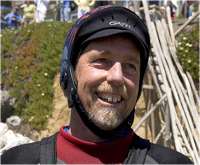Follow the spirits and chase those demons
I’m not sure if it was 1997 or 1998. Or 1999 even. But in spite of not remembering the year, I remember the specific symposium when the Tsunami Rangers came to town. The West Coast Sea Kayak Symposium was, back then, the ultimate in kayaking events anywhere and traveling to Port Townsend on the third weekend in September was a kayaker’s version of making the hajj. The California-based Tsunami Rangers were the featured speakers at that particular symposium and I didn’t know what to make of them.
I still don’t know what to make of them, to be honest. They are solid paddlers – there’s not much need for discussion on that point – and they may seem a bit crazy, but that is not a bad thing. It’s an aging group (the same could be said for kayakers in general), but their accomplishments are impressive. Although individual members have achieved various certifications from the kayaking powers that be – such as they are – the group seems to have ignored any external validation. Founding member Eric Soares (left) passed away earlier this year but he left a legacy and a body of work that will live on for quite some time.
The Rangers made their own boats too. The X-1 Rocket was their first, and they later produced the X-15 Scramjet as well as a double. All sit-on-tops, all overbuilt, all made for hearty abuse in the unforgiving, rocky impact zone where the water meets the land.
In all honesty, the X-1 was made for someone with shorter legs than mine, and a smaller butt. I could probably modify it to work for me but I likely won’t. It paddled well and had an ability to turn like a whitewater boat while the large rudder also made tracking easy. It accelerated nicely and while it wasn’t particularly stable initially, it had a decent secondary holding spot that made it seem solid enough. I didn’t roll it, didn’t even do a rescue, but I can’t imagine it would be too difficult. (I might want to put thigh straps on it if I was going to paddle it a lot though; I think that would increase the handling capabilities.) It wasn’t easy to carry… could use a handle or a shoulder-rigged system.











